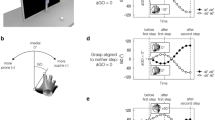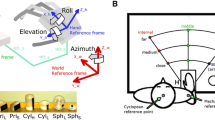Abstract
The present experiment examined the influence of final target position on grasp posture planning during a three-segment object manipulation task in which the required object orientation at the first target position was unconstrained. Participants grasped a cylindrical object from a home position, placed it at an intermediate position in a freely chosen orientation, and subsequently placed it at one of four final target positions. Considerable inter-individual differences in initial grasp selection were observed which also led to differences in final grasp postures. Whereas some participants strongly adjusted their initial grasp postures to the final target orientation, and thus showed a preference for end-state comfort, other participants showed virtually no adjustment in initial grasp postures, hence satisfying initial-state comfort. Interestingly, as intermediate grasp postures were similar regardless of initial grasp adjustment, intermediate-state comfort was prioritized by all participants. These results provide further evidence for the interaction of multiple action selection constraints in grasp posture planning during multi-segment object manipulation tasks. Whereas some constraints may take strict precedence in a given task, other constraints may be more flexible and weighted differently among participants. This differentiated weighting leads to task- and subject-specific constraint hierarchies and is reflected in inter-individual differences in grasp selection.








Similar content being viewed by others
Notes
The Woltring filter is commonly used in the analysis of motion capture data and is equivalent to a double Butterworth filter. The benefit to the Woltring filter is that higher-order derivates can be calculated from the analytic derivative of a polynominal spline.
Here, the symbol × is used to denote the cross product of two vectors.
Given that participants were instructed to maintain the initially adopted grasp posture throughout the entire movement sequence, intermediate hand and object orientation angles cannot be assumed to be independent. To account for this interdependency, we initially performed a RM MANOVA on intermediate angels.
Notably, the difference between intermediate object orientation and intermediate hand orientation angle was larger for the −90° and −45° final target positions (difference = 6.8° and 0.4°, respectively) compared to the 45° and 90° target positions (difference = 20.3° and 30.0°, respectively). These differences reflect the generally stronger adjustment in initial grasp postures to the 45° and 90° final targets and are likely to result from biomechanical asymmetries in the range of motion of the arm.
References
Ashman KM, Bird CM, Zepf SE (1994) Detecting bimodality in astronomical datasets. Astron J 108:2348–2361
Cos I, Belanger N, Cisek P (2011) The influence of predicted arm biomechanics on decision making. J Neurophysiol 105:3022–3033
Cos I, Medleg F, Cisek P (2012) The modulatory influence of end-point controllability on decisions between actions. J Neurophysiol 108:1764–1780
Dragovich M (2004) Categorization and validation of handedness using latent class analysis. Acta Neuropsychiatr 16:212–218
Fischman MG, Stodden D, Lehmann D (2003) The end-state comfort effect in bimanual grip selection. Res Q Exerc Sport 74:17–24
Haggard P (1998) Planning of action sequences. Exp Brain Res 118:286–292
Harris CM, Wolpert DM (1998) Signal-dependent noise determines motor planning. Nature 394:780–784
Herbort O, Butz MV (2012) The continuous end-state comfort effect: weighted integration of multiple biases. Psychol Res 76:345–363
Hesse C, Deubel H (2010) Advance planning in sequential pick-and-place tasks. J Neurophysiol 104:508–516
Hogan N (1984) An organizing principle for a class of voluntary movements. J Neurosci 4:2745–2754
Hogan N, Flash T (1987) Moving gracefully: quantitative theories of motor coordination. Trends Neurosci 10:170–174
Hughes CML, Franz EA (2008) Goal-related planning constraints in bimanual grasping and placing of objects. Exp Brain Res 188:541–550
Hughes CML, Haddad JM, Franz EA, Zelaznik HN, Ryu JH (2011) Physically coupling two objects in a bimanual task alters kinematics but not end-state comfort. Exp Brain Res 211:219–229
Hughes CML, Seegelke C, Schack T (2012a) The influence of initial and final precision on motor planning: individual differences in end-state comfort during unimanual grasping and placing. J Mot Behav 44:195–201
Hughes CML, Seegelke C, Reißig P, Schütz C (2012b) Effects of stimulus cueing on bimanual grasp posture planning. Exp Brain Res 219:391–401
Hughes CML, Seegelke C, Spiegel MA, Oehmichen C, Hammes J, Schack T (2012c) Corrections in grasp posture in response to modifications of action goals. PLoS One 7:e43015
Napier J (1956) The prehensile movements of the human hand. J Bone Jt Surg 38 B:902–913
Rosenbaum DA, Marchak F, Barnes HJ, Vaughan J, Slotta JD, Jorgensen MJ (1990) Contsraints for action selection: Overhand versus underhand grips. In: Jeannerod M (ed) Attention and performance XIII. Erlbaum, Hillsdale, pp 321–342
Rosenbaum DA, van Heugten CM, Caldwell GE (1996) From cognition to biomechanics and back: the end-state comfort effect and the middle-is-faster effect. Acta Psychol 94:59–85
Rosenbaum DA, Meulenbroek R, Vaughan J, Jansen C (2001) Posture-based motion planning: applications to grasping. Psychol Rev 108:709–734
Rosenbaum DA, Chapman KM, Weigelt M, Weiss DJ, van der Wel R (2012) Cognition, action, and object manipulation. Psychol Bull 138:924–946
Rosenbaum DA, Chapman KM, Coelho CJ, Gong L, Studenka BE (2013) Choosing actions. Front Psychol 4:273
Schütz-Bosbach S, Prinz W (2007) Prospective coding in event representation. Cogn Process 8:93–102
Seegelke C, Hughes CML, Schack T (2011) An investigation into manual asymmetries in grasp behavior and kinematics during an object manipulation task. Exp Brain Res 215:65–75
Seegelke C, Hughes CML, Schütz C, Schack T (2012) Individual differences in motor planning during a multi-segment object manipulation task. Exp Brain Res 222:125–136
Seegelke C, Hughes CM, Knoblauch A, Schack T (2013) Grasp posture planning during multi-segment object manipulation tasks: interaction between cognitive and biomechanical factors. Acta Psychol 144:513–521
Stöckel T, Hughes CML, Schack T (2012) Representation of grasp postures and anticipatory motor planning in children. Psychol Res 76:768–776
Uno Y, Kawato M, Suzuki R (1989) Formation and control of optimal trajectory in human multijoint arm movement. Biol Cybern 61:89–101
van der Wel RPRD, Rosenbaum DA (2010) Bimanual grasp planning reflects changing rather than fixed constraint dominance. Exp Brain Res 205:351–362
Wilson M, Knoblich G (2005) The case for motor involvement in perceiving conspecifics. Psychol Bull 131:460–473
Woltring HJ (1986) A Fortran package for generalized, crossvalidatory spline smoothing and differentiation. Adv Eng Softw Workst 8:104–133
Zhang W, Rosenbaum DA (2008) Planning for manual positioning: the end-state comfort effect for manual abduction–adduction. Exp Brain Res 184:383–389
Acknowledgments
This research was funded by the German Research Foundation (DFG: EC 277). Christian Seegelke gratefully acknowledges the financial support from Honda Research Institute Europe.
Author information
Authors and Affiliations
Corresponding author
Rights and permissions
About this article
Cite this article
Seegelke, C., Hughes, C.M.L., Knoblauch, A. et al. The influence of reducing intermediate target constraints on grasp posture planning during a three-segment object manipulation task. Exp Brain Res 233, 529–538 (2015). https://doi.org/10.1007/s00221-014-4133-4
Received:
Accepted:
Published:
Issue Date:
DOI: https://doi.org/10.1007/s00221-014-4133-4




